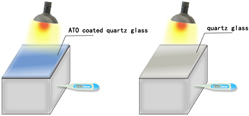Article contents
Dispersion of antimony doped tin oxide nanopowders for preparing transparent thermal insulation water-based coatings
Published online by Cambridge University Press: 13 June 2017
Abstract

Antimony doped tin oxide (ATO) is an ideal material for thermal insulation. To obtain the stable performance of ATO nanodispersions and measure the transparent and thermal insulation properties of the ATO coatings, we investigated how a dispersant and sand milling affect the stability of ATO dispersion, which has come to the results that adding an appropriate dispersant and sand milling for 2.0 h were beneficial to the ATO dispersion. We characterized the morphology, nanostructure, particle size distribution, zeta potential, and optical properties of the ATO dispersions by a transmission electron microscope (TEM), a laser particle size analyzer, and a spectrometer. The results show that the average particle size of the dispersions is about 50 nm and their absolute values of all zeta potentials are more than 40 mV. We coated the thermal insulation water-based coatings on quartz glasses by spin coating method, the effect of thermal insulation is evident with the increase of the ATO content, and there exists approximately 10 °C difference between the ATO sample and blank sample with the condition for maintaining high transmittance of visual light.
Keywords
- Type
- Articles
- Information
- Copyright
- Copyright © Materials Research Society 2017
Footnotes
Contributing Editor: Sam Zhang
References
REFERENCES
- 11
- Cited by



